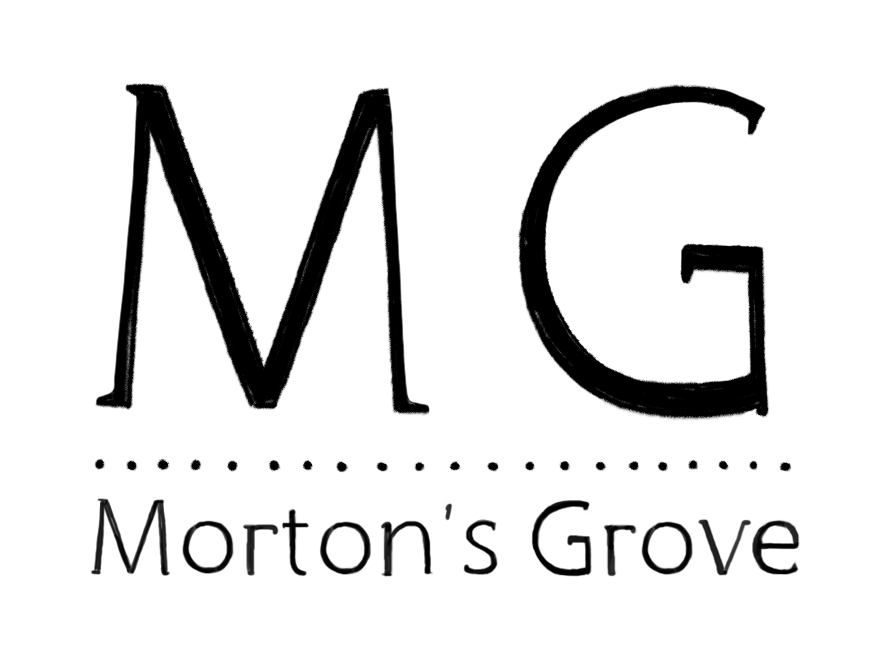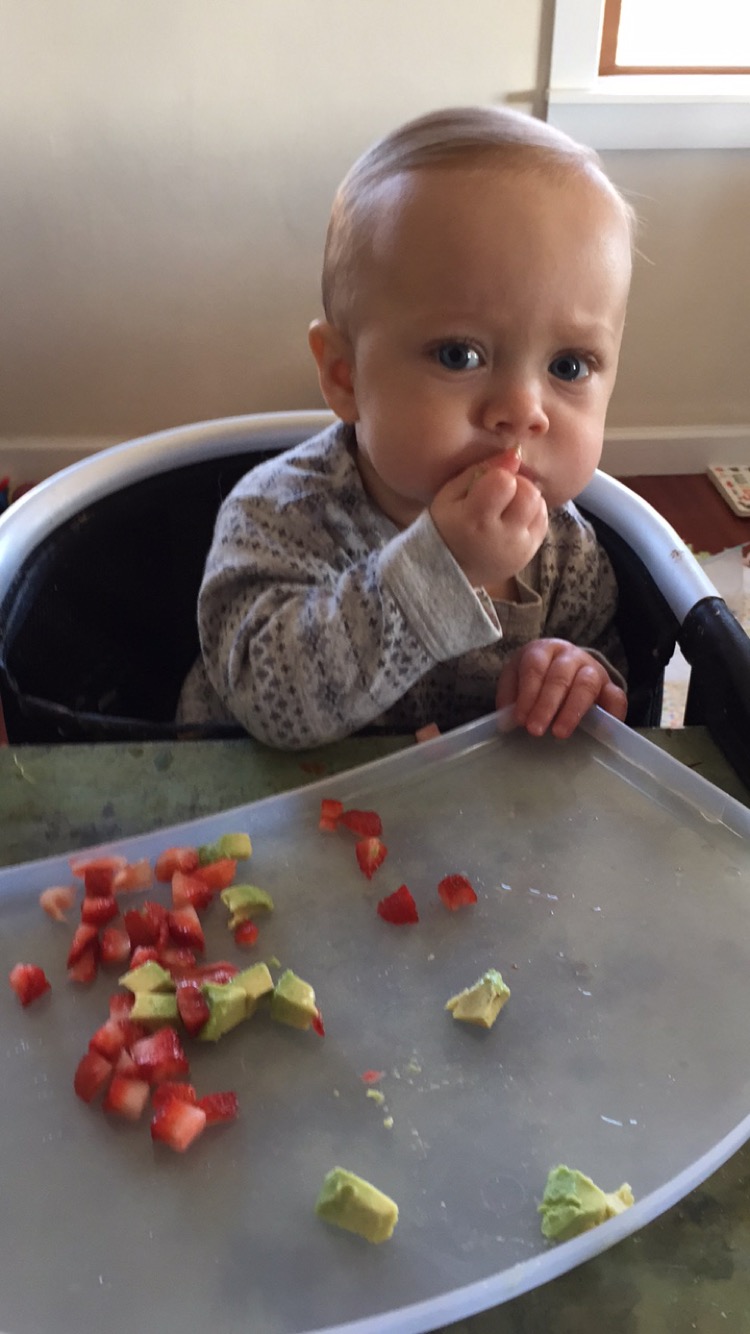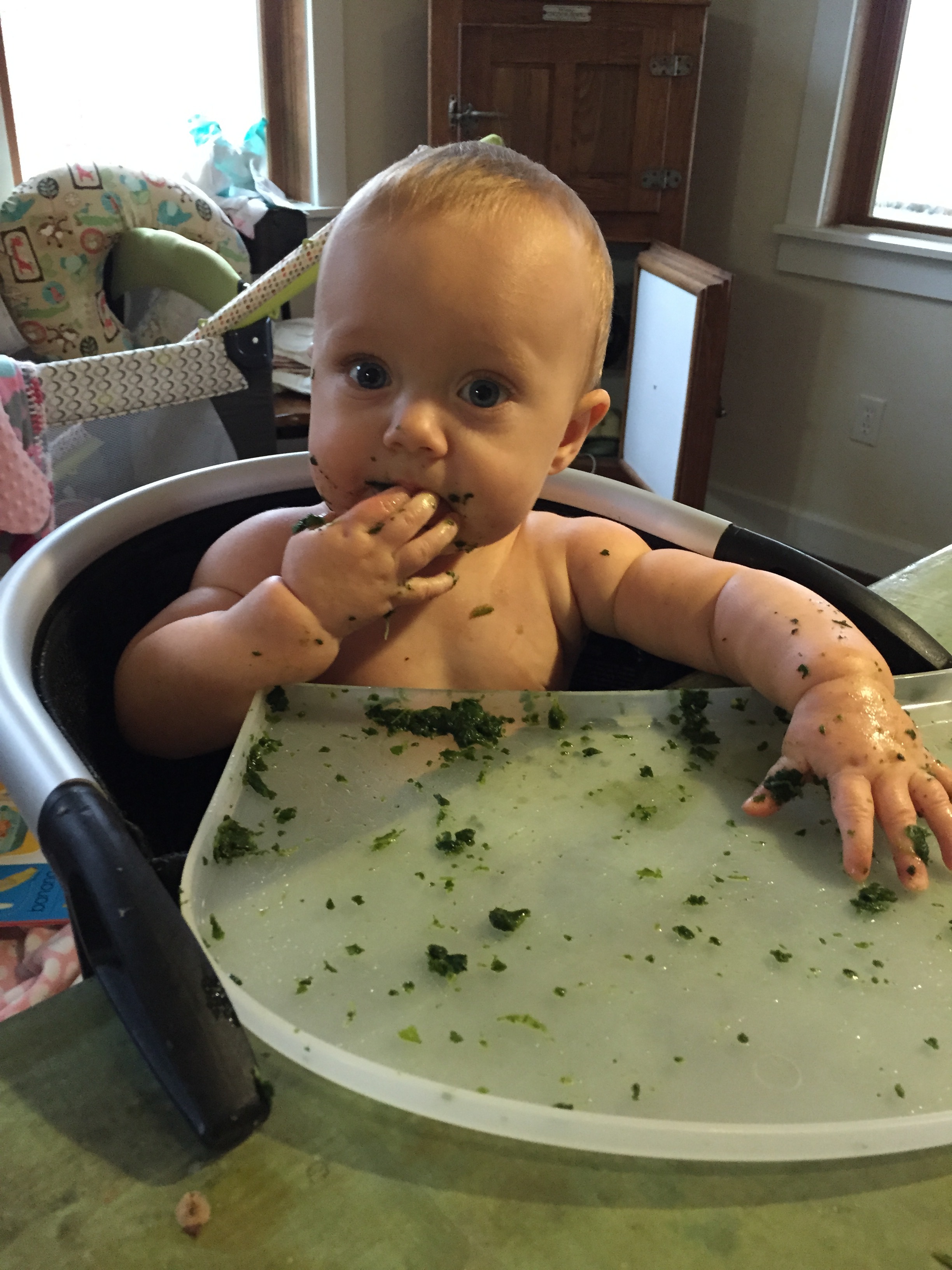Ruthie was somewhere around 6 months old when she officially tried food for the first time. Unofficially, she's licked plenty of avocado spoons and there was an incident where some squash dropped onto the floor (but can we please pretend my daughter didn't eat her first foods off of the floor 🙈?) ANYWAY, I had just recently started trying out her chair so I could cook dinner and chat with her at the same time. I was roasting a variety of squashes both butternut AND pumpkin because that's one of the things one does in October when one has been inspired by Martha's Pinterest feed. I had split the squarshes in half and drizzled them with olive oil and cinnamon. Ruthie was giving me the eye so I smooshed a few pieces and put them on her tray. She stared at the squash, stared at her hands, stared at me. And after MINUTES of contemplation I'll be damned if she didn't use her chubby little hands to smash that piece of squash somewhere near her mouth. This went on for a while and I'd estimate she actually consumed about 1/8th of a teaspoon of food, but I felt like it was a total success.
Strawberry & avocado.
After that, we tried avocado slices, ripe banana, mushed black beans, scrambled eggs, sticks of cold watermelon to soothe new teefs, pasta, slow cooked chicken, spinach sautéed in olive oil, mashed sweet potatoes, oatmeal, lentils, diced tomatoes with basil, and on and on. It made/makes sense to try to make the food taste appealing, so I roasted veggies with olive oil before serving soft/smashed or pureeing, mixed tart berry puree with creamy yogurt, blended herbs like basil and cilantro into vegetables, topped oatmeal with cinnamon and mixed in peanut butter. Most of the time Ruthie fed herself, but there were definitely times when I offered a friendly spoonful. I suppose you could call our feeding method slightly modified baby-led weaning (BLW).
BLW is an alternative to spoon feeding that starts with whole foods often in sticks or small chunks for baby to self feed starting around 6 months of age - taking cues from your babe on when to begin.
Baby-led feeding puts babe in charge of how much she eats, with mom in charge of what and where she eats. Babies are so incredibly smart and in tune with their bodies. A baby-led approach helps them to regulate on their own how much they eat based on internal cues. Some research suggests this ability to tune into internal feelings of hunger and fullness extends into adulthood.
A lot of the emphasis in BLW is on parent involvement and observation with special focus on making feeding a positive experience. Because baby needs to be physically and developmentally capable of eating foods with some texture vs purée (sitting on own with trunk control, bringing hand to mouth), baby-led feeding becomes appropriate AROUND 6 months of age (possibly a little after, know one knows your sweet babe better than you!). That goes along with recommendation from The World Health Organization and the American Academy of Pediatrics to exclusively breastfeed from birth through 6 months.
Cranberry puree with banana chunks - why didn't I ever use a bib?
One of my goals in feeding Ruthie was to introduce as many foods as possible before her first birthday. Research suggests there is window of time between 6-14 months when baby is most accepting of new flavors and textures and this early acceptance can carry into childhood AND BEYOND (buzz lightyear style). Another focus of BLW is introduction of a ton of different foods. Ruthie rarely gagged on food, so I quickly became comfortable offering her a big variety.
Since I often gave Ruthie small pieces (not the larger ones you typically see with baby-led feeding), she developed a pretty rad Palmer grasp to help her get food to her mouth and didn’t get too frustrated with the size of the food. This Palmer grasp eventually developed into a pincer grasp we all know and love.
SO as you may already know, babies sometimes gag when introduced to solids (solids meaning any food other than breast milk or formula), it doesn't matter if its super thinned out cereal or a chunk of avocado. That reflex is there to help them regulate the amount of food they swallow, and not to cause panicky moms like me to have a heart attack. Some babies do this a lot more frequently than others (here’s a handy article on choking vs gagging).
Frozen spinach sauteed with a little olive oil.
I had a few goals when introducing new foods to Ruthie, the main one being I always want her to view food as amazing, delicious, wonderful, and only, ONLY a positive thing. That goal is a work in progress, but at this age working towards that goal means not bringing any stress to the table and keeping mealtimes happy and as laid back as I can muster (just a cool & casual mom, I am the sunglasses emoji at mealtimes). Beyond these, a few other early feeding goals:
1. Understand what fruits and vegetables look like, taste like, feel like.
2. Associate the motion of feeding herself with the feeling of fullness.
4. Enjoy eating. Since she was mainly feeding herself, she remained in control to continue eat the things she liked and stop eating anything she didn't like.
5. Early exposure to allergenic foods (eggs, dairy, peanuts, seafood, wheat).
6. Understand that families eat together. The same foods even!
Babies 6-12 months get most of the nutrition they need (even most iron!!) from breast milk or fortified formula. Introducing a variety of foods is SO important, but whether you offer purees or whole foods via baby-led feeding or some combination of the two, it is more about learning to eat real foods of many different textures (and learning to enjoy eatin'!!) than it is what specific food baby eats. Eating is a learning experience that babies need some time to get the hang of.
Going through these photos of Ruthie learning to eat brought back memories of how excited I got every time she tried something new. She never met a food she didn't like. I just absolutely love food and I want that for her as well, right from the very beginning.
One of her faves, orange slices.
The information in this article is general in nature and intended to share my personal experiences, it is not medical advice. Please discuss any medical concerns with your physician.







